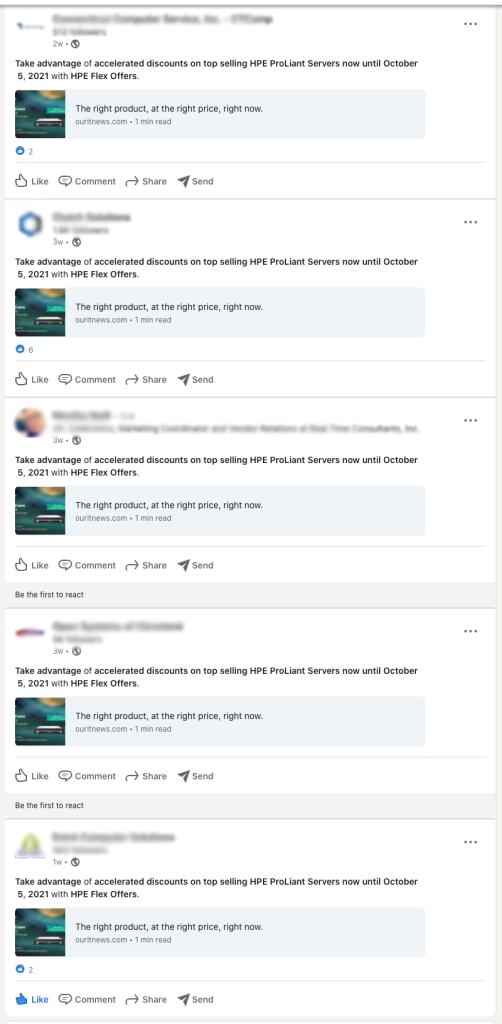As more businesses in the IT Channel incorporate social marketing and sales into their promotional mix, we see a recurring pattern of approaches, challenges and pitfalls. There isn’t one correct way to do social marketing and sales, but there are ways to improve your chances of developing a productive and sustainable practice.
First, let’s address some of the common approaches and pitfalls.
Automating Your Brand Voice
One of the most frequent mistakes we see resellers, MSPs and solution providers make in social media is turning over their entire social feed to canned OEM or distributor feeds through social content syndication. The idea seems attractive: instead of shouldering the investment required to build your own social feed, you can just subscribe to a feed of posts delivered by your favorite OEMs and reshare them to your own accounts.
There are several problems with this approach, beyond the fact that it produces few measurable results. First and foremost, there is absolutely nothing social about it. The vast majority of channel partners that follow this approach never pay attention to what they’re posting and simply turn their social feed into a blind billboard. Sure, you may win a few brownie points for amplifying someone else’s brand, but you undermine your own brand credibility. How, you might ask? Check out the image.

One of the most common ways people will find your social media content is through search. When someone searches a key-phrase that hits one of your canned posts, guess what? The results pull up all the canned posts that contain the same phrase. You immediately show up to any discerning buyer as one of those businesses associated with noise, not a differentiated solution.
Outsourcing Your Brand Voice
Hiring an outside firm or freelancer to manage your company’s feed is fine, but obviously comes with its own challenges. Plenty of marketing firms offer social media management services, but most are focused on consumer-oriented content and strategy, so you’ll want to find a B2B-focused agency, preferably one with experience promoting the kinds of technology services you offer. Good luck.
You’ll likely find it easier to hire a freelancer. A good place to start is by looking for a freelance technical writers that has added social media services to their resume. You’ll want to look at examples of feeds they’ve managed, and ensure that their style and philosophy toward posting matches your brand and business objectives. Be clear about your expectations, including frequency of posting, topics and themes, anticipated outcomes and KPIs, response management and review cycles.
Now let’s look at some of the approaches for developing your capabilities in house.
Hiring a Social Media Manager
Hiring a dedicated or part-time Social Media Manager is another approach we see a lot of solution providers adopting. As long as you’re clear about your expectations and objectives, this is a perfectly good option, though this is where we usually see the pitfalls arise.
Too often, the objectives are vaguely summarized around improving the company’s visibility on social media, with hiring focused on candidates a year or two out of college with a communications degree. What that typically produces is a more consistent cadence of social posts on LinkedIn and Twitter, but little progress in effective positioning, demand generation or sales.
If you plan to take this route, we would suggest reviewing your strategic plan and clearly hiring for the strategic objective you want to pursue. Ideally you’ll want to hire someone with more than just a good understanding of social media tactics and tools, but also an understanding of how social marketing interfaces with SEO, digital marketing and lead generation if not sales.
The main idea at this stage is not to hire someone who will be learning on the job with you, but someone who can help you build the foundation of solid social market development practice.
Developing an Internal Social Media A-Team
This is our favorite approach for most resellers and solution providers actively trying to improve their social marketing and sales performance. The idea is to divide roles and responsibilities across a cross-functional team, including at least members of marketing and sales, but ideally also engineering and management. This approach ensures that everyone in the organization understands the importance of the activity, that varied perspectives are brought to the effort, and that teamwork will galvanize the group in activity toward a common goal.
Ideally this is a voluntary program that will draw on individuals intrinsically motivated to participate. It’s fine to make it a game and offer rewards, but requiring participation will often undermine morale and performance.
Just as there is no single “right way” to participate in social marketing or sales, it’s not an activity that is right for everyone. At the same time, we often see some of the most unexpected people excelling in social media when given an opportunity. That’s why we often recommend an invitational and progressively competitive approach, rewarding participants initially for participation and later for performance and results.
Building Your Own A-Team
The main idea behind an A-Team is to broaden the base of your brand voice by involving more people in creating content to post to your business accounts. This not only adds more perspectives and variety, but the teamwork helps carry momentum through the inevitable ebbs and flows of finding a consistent and sustainable rhythm.
Each person on the A-Team shouldn’t try to adopt the company’s marketing voice. Instead, each should bring their own experience and point of view to contribute to the brand story. Here’s how we break down the roles and the perspective of value each player brings to the story:
- Sales: What are customers talking about? What’s keeping them up at night?
- Marketing: What’s happening that prospects and customers should know about?
- Engineering: What technology trends are driving product and solution development?
- Executives: What industry trends are driving product and business decisions?
If each of those roles are filled on your A-Team with just one person contributing one social post per week, you’d have 80% of a week-day cadence for your corporate social media feed.
We recommend organizing your team activity into six week sprints, with a simple content calendar defining a topic for focus for each week. Then meet once a week to discuss the coming week’s topic, brainstorm post ideas, discuss what posting approaches you want to try out, and workshop what worked or didn’t work the previous week.
Growing Beyond Your A-Team
For companies looking to explore the value of social marketing and sales, the mix of perspectives and ideas makes an A-Team a strong approach for discovery and development. It can also function as a transitional catalyst to building a dedicated social marketing practice–the A-Team would be used to explore the right brand voice, cadence and content mix, and then hire a Social Media Manager to coordinate team activities, and grow from there. The advantage in this approach is the organic development of the brand voice, the broader inclusion of cross-functional team members, and the leveraging a Social Media Manager to formalize what the team develops rather than formulate the brand voice on their own.
If you’re a channel VAR, reseller or solution provider and you’re interested in developing your own A-Team, we have more details and materials for you to draw on. Just connect with us on LinkedIn and ask. If you have access to MDF that you want to utilize for A-Team development, we have an MDF-compliant A-Team program that fits into a typical quarterly OEM marketing calendar.

